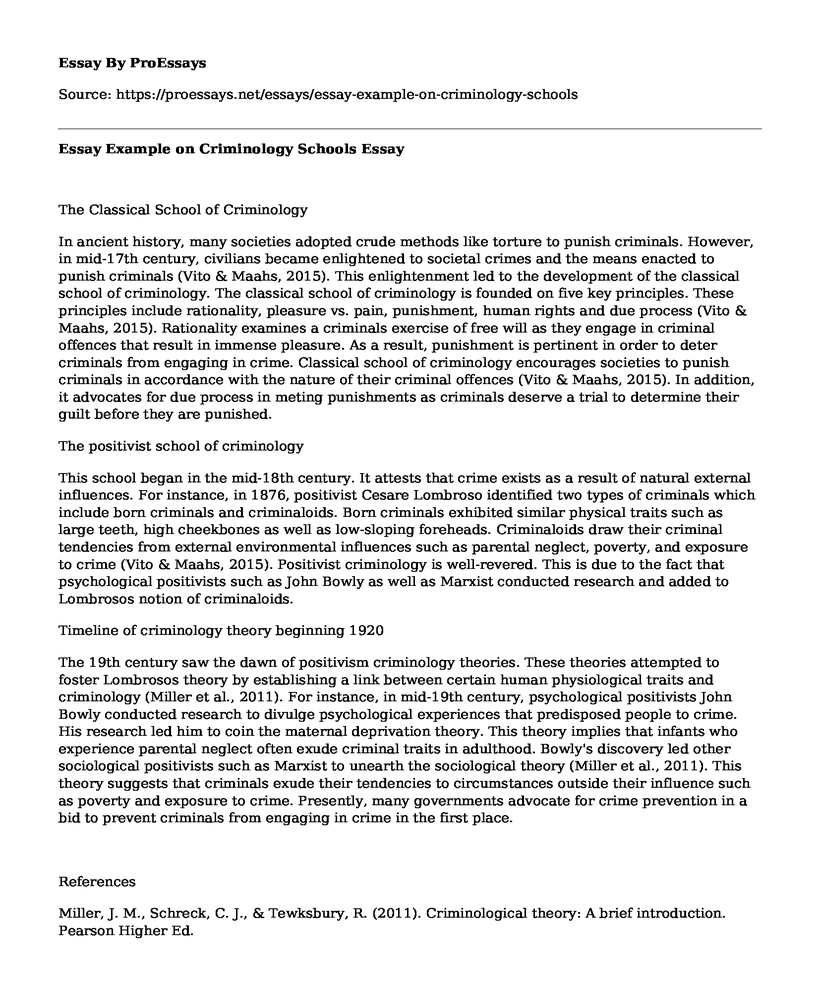The Classical School of Criminology
In ancient history, many societies adopted crude methods like torture to punish criminals. However, in mid-17th century, civilians became enlightened to societal crimes and the means enacted to punish criminals (Vito & Maahs, 2015). This enlightenment led to the development of the classical school of criminology. The classical school of criminology is founded on five key principles. These principles include rationality, pleasure vs. pain, punishment, human rights and due process (Vito & Maahs, 2015). Rationality examines a criminals exercise of free will as they engage in criminal offences that result in immense pleasure. As a result, punishment is pertinent in order to deter criminals from engaging in crime. Classical school of criminology encourages societies to punish criminals in accordance with the nature of their criminal offences (Vito & Maahs, 2015). In addition, it advocates for due process in meting punishments as criminals deserve a trial to determine their guilt before they are punished.
The positivist school of criminology
This school began in the mid-18th century. It attests that crime exists as a result of natural external influences. For instance, in 1876, positivist Cesare Lombroso identified two types of criminals which include born criminals and criminaloids. Born criminals exhibited similar physical traits such as large teeth, high cheekbones as well as low-sloping foreheads. Criminaloids draw their criminal tendencies from external environmental influences such as parental neglect, poverty, and exposure to crime (Vito & Maahs, 2015). Positivist criminology is well-revered. This is due to the fact that psychological positivists such as John Bowly as well as Marxist conducted research and added to Lombrosos notion of criminaloids.
Timeline of criminology theory beginning 1920
The 19th century saw the dawn of positivism criminology theories. These theories attempted to foster Lombrosos theory by establishing a link between certain human physiological traits and criminology (Miller et al., 2011). For instance, in mid-19th century, psychological positivists John Bowly conducted research to divulge psychological experiences that predisposed people to crime. His research led him to coin the maternal deprivation theory. This theory implies that infants who experience parental neglect often exude criminal traits in adulthood. Bowly's discovery led other sociological positivists such as Marxist to unearth the sociological theory (Miller et al., 2011). This theory suggests that criminals exude their tendencies to circumstances outside their influence such as poverty and exposure to crime. Presently, many governments advocate for crime prevention in a bid to prevent criminals from engaging in crime in the first place.
References
Miller, J. M., Schreck, C. J., & Tewksbury, R. (2011). Criminological theory: A brief introduction. Pearson Higher Ed.
Vito, G. F., & Maahs, J. R. (2015). Criminology. Jones & Bartlett Publishers.
Cite this page
Essay Example on Criminology Schools. (2021, Apr 01). Retrieved from https://proessays.net/essays/essay-example-on-criminology-schools
If you are the original author of this essay and no longer wish to have it published on the ProEssays website, please click below to request its removal:
- Playing God: Death Penalty Cons
- Judicial Systems of Brazil and Canada
- We Are in Fact Animals Essay Example
- US Terrorism and Homeland Security: I Am Malala
- Essay Example on Solitary Confinement: A Growing Problem in US Prisons
- Essay on AFL: An Organizational Solution to Employer-Worker Conflict in US History
- Essay Sample on Children & Police







